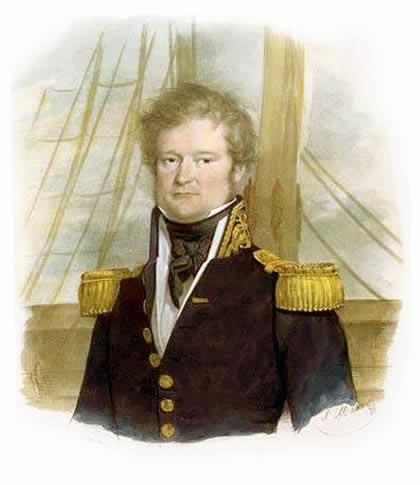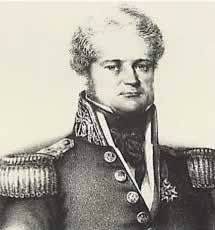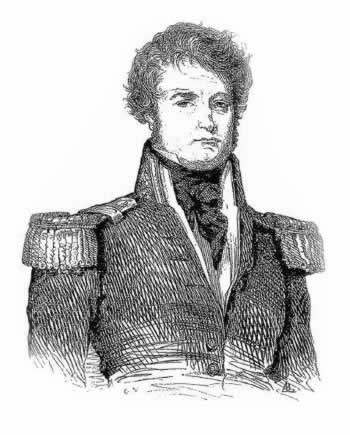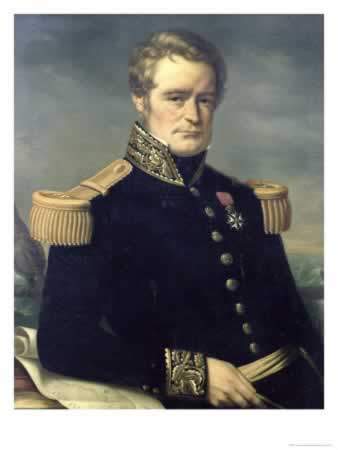Think that you may own a portrait of Jules Dumont? We authenticate, appraise and issue Certificates of Authenticity (COA) for all portraits of Jules Dumont.

Jules Dumont, Artist Unknown
Jules Dumont was a French explorer and naval officer, who explored the south and western Pacific, Australia, New Zealand, and Antarctica. Dumont's father Gabriel Charles François Dumont d'Urville and Bailiff of Condé-sur-Noireau (1728 - 1796) was, like his ancestors, responsible for the court of Condé. His mother Jeanne Françoise Victoire Julie (1754 - 1832) came from Croisilles, Calvados and was a rigid and formal woman coming from an ancient family of the rural nobility of Basse-Normandie. He was weak and often sickly. After the death of his father when he was six, his mother's brother, the Abbot of Croisilles, played the part of his father and from 1798 was in charge of his education. The Abbot taught him Latin, Greek, rhetoric and philosophy. From 1804 Dumont studied at the lycée Impérial in Caen. In Caen's library he began to read the encyclopédists and the reports of travel of Bougainville, Cook and Anson, and he became deeply passionate about these matters. At the age of 17 years he failed the physical tests of the entrance exam to the École Polytechnique and he therefore decided to enlist in the navy.
There are no known portraits from his youth, though it is quite likely that they exist. Dumont came from a noble family, so it is likely that portraits of Dumont as a baby or a child will surface some day. He also may be featured in group family portraits or in portraits when he was a young man. This is just speculation, but a very real possibility.
In 1807 Dumont was admitted to the Naval Academy at Brest where he presented himself as a timid young man, very serious and studious, little interested in amusements and much more interested in studies than in military matters. In 1808, he obtained the grade of first class candidate.
At the time the French navy was only a neglected "cousin", of a much lower quality than Napoleon's army and its ships were blockaded in their ports by the absolute domination of the Royal Navy. Dumont was confined to land like his colleagues and spent the first years in the navy studying foreign languages. In 1812, after having been promoted to ensign and finding himself bored with port life and disapproving of the dissolute behavior of the other young officers, he asked to be transferred to Toulon on board the ‘'Souffren''; but this ship was also blockaded in port.
In this period Dumont built on his already substantial cultural knowledge. He already spoke, in addition to Latin and Greek, English, German, Italian, Russian, Chinese and Hebrew. During his later travels in the Pacific, thanks to his prodigious memory, he acquired some knowledge of an immense number of dialects of Polynesia and Melanesia. He learnt about botany and entomology in long excursions in the hills of Provence and he studied in the nearby naval observatory.
Finally Dumont undertook his first short navigation of the Mediterranean Sea in 1814, when Napoleon had been exiled to Elba. In 1816, he married Adèlie Pepin, daughter of a clockmaker from Toulon, who was openly disliked by Dumont's mother, who thought her inappropriate for her son and refused to meet her and, later on, her grandsons from the marriage.
In 1819 Dumont d'Urville sailed on board the Chevrette, under the command of Captain Gauttier-Duparc, to carry out a hydrographic survey of the islands of the Greek archipelago. During a pause near the island of Milos, the local French representative brought to Dumont's attention the rediscovery of a marble statue a few days before (1820-04-08) by a local peasant. The statue, now known as the Venus de Milo is a masterpiece that was carved around the year 130 BC. Dumont recognized its value and would have acquired it immediately, but the ship's commander pointed out that there was not enough space on board for an object of its size. Moreover, the expedition was likely to proceed through stormy seas that could damage it. Dumont then wrote to the French ambassador to Constantinople about its discovery. The Chevrette arrived in Constantinople on 22 April and Dumont succeeded in convincing the ambassador to acquire the statue.
Meanwhile, the peasant had sold the statue to a priest, Macario Verghis, who wished to present it as a gift to an interpreter for the Sultan in Constantinople. The French ambassador's representative arrived just as the statue was being loaded aboard a ship bound for Constantinople and persuaded the islands primates (chief citizens) to annul the sale and honour the first offer. This earned Dumont the title of Chevalier (knight): of the Légion d'honneur, the attention of the French Academy of Sciences and promotion to lieutenant and France a new, magnificent statue for the Louvre in Paris.
On his return from the voyage of the Chevrette, Dumont was sent to the naval archive where he came across Lieutenant Louis Isidore Duperrey, an acquaintance from the past. The two began to plan an expedition of exploration in the Pacific, an area from which France had been forced out of during the Napoleonic Wars. France considered it might be able to regain some of its losses by taking over part of New South Wales. In August 1822 the ship Coquille sailed from Toulon with the objective of collecting as much scientific and strategic information as possible on the area to which it was dispatched. Duperrey was named Commander of the expedition because he was four years older than Dumont.
René-Primevère Lesson also traveled on the Coquille as a naval doctor and naturalist. On the return to France in March 1825, Lesson and Dumont brought back to France an imposing collection of animals and plants collected to the Falkland Islands, on the coasts of Chile and Peru, in the archipelagos of the Pacific and New Zealand, New Guinea and Australia. Dumont was now 35 and in poor health. On board the Coquille, he had behaved as a competent official, but rather abrupt, little inclined to socialize and with a sometimes embarrassing lack of interest in his physical condition and medical and hygiene advice. On the return to France, Duperrey was promoted to commander, while Dumont was promoted to a lower rank, even after having been on his best behavior. This greatly disturbed Dumont in subsequent years.

Jules Dumon, seated portrait, Artist Unknown
On the Coquille, Dumont tried to reconcile his responsibilities as second in command with his need to carry out scientific work. He was in charge of carrying out research in the fields of the botany and entomology. The ‘'Coquille'' brought back to France specimens of more than 3,000 species of plants, 400 of which were previously unknown, enriching moreover the Muséum national d'histoire naturelle in Paris with more than 1,200 specimens of insects, covering 1,100 insect species (including 300 previously unknown species). The scientists Georges Cuvier and François Arago analyzed the results of his searches and praised Dumont.
Two months after Dumont returned on the Coquille, he presented to the Navy Ministry a plan for a new expedition, which he hoped to command, as his relationship with Duperrey had deteriorated. The proposal was accepted and the Coquille, renamed the Astrolabe in honor of the ship of La Pérouse, sailed from Toulon at the beginning of 1826 towards the Pacific Ocean, for a circumnavigation of the world that was destined to last nearly three years.
The new Astrolabe skirted the coast of southern Australia, carried out new relief maps of the South Island of New Zealand, reached the archipelagos of Tonga and Fiji, executed the first relief maps of the Loyalty Islands (part of French New Caledonia) and explored the coasts of New Guinea. He identified the site of La Pérouse's shipwreck in Vanikoro (one of the Santa Cruz Islands, part of the archipelago of the Solomon Islands) and collected numerous remains of his boats. The voyage continued with the mapping of part of the Caroline Islands and the Moluccas. The Astrolabe returned to Marseilles during the early months of 1829 with an impressive load of hydrographical papers and collections of zoological, botanical and mineralogical reports, which were destined to strongly influence the scientific analysis of those regions. Following this expedition, he invented the terms Micronesia and Melanesia, distinguishing these Pacific cultures and island groups from Polynesia.
Dumont's health was by now weakened by years of a poor diet. He suffered from kidney and stomach problems and from intense attacks of gout. During the first thirteen years of their marriage, half of which passed far apart, Adéle and Jules had two sons. The first one died at a young age while his father was to board the Coquille and the second, also called Jules, on the return of his father after four years away.

Jules Dumont, 1830, Artist Unknown
Dumont d'Urville passed a short period with his family before returning to Paris, where he was promoted to captain and he was put in charge of writing the report of his travels. The five volumes were published at the expense of the French government between 1832 and 1834. During these years d'Urville, who was already a poor diplomat, became more irascible and rancorous as a result of his gout, and lost the sympathy of the naval leadership. In his report, he criticized harshly the military structures, his colleagues, the French Academy of Sciences and even the King - none of which, in his opinion, had given the voyage of the Astrolabe due acknowledgment.
In 1835, Dumont was directed to return to Toulon to engage in "down to earth" work and spent two years, marked by mournful events (notably the loss of a daughter from cholera) and happy events (notably the birth of another son, Émile) but with the constant and nearly obsessive thought of a third expedition to the Pacific, analogous to James Cook's third voyage. He looked again at the Astrolabe's travel notes, and found a gap in the exploration of Oceania and, in January 1837, he wrote to the Navy Ministry suggesting the opportunity for a new expedition to the Pacific.

Jules Dumont, bust
King Louis-Philippe approved the plan, but he ordered that the expedition aim for the South Magnetic Pole and to claim it for France; if that was not possible, Dumont's expedition was asked to equal the most southerly latitude of 74°34'S achieved in 1823 by James Weddell. Thus France became part of the international competition for polar exploration, along with the United States and the United Kingdom.
Dumont was initially unhappy with the modifications made to his proposal. He had little interest in polar exploration and preferred tropical routes. But soon his vanity took over and he saw the opportunity for achieving a prestigious objective. The two ships, ‘'Astrolabe'' and ‘'Zélée'', commanded by Charles Hector Jacquinot, were prepared for the voyage at Toulon. In the course of the preparation Dumont also went to London to acquire documentation and instrumentation, meeting the British Admiralty's oceanographer, Francis Beaufort and the President of the Royal Geographical Society, John Washington, both strong supporters of the British expeditions to the South Pole.
The Astrolabe and the Zélée sailed from Toulon on 7 September 1837, after three weeks of delay compared to Dumont's plans. His objectives were to reach the more southerly point possible at this time in the Weddell Sea; to pass through the Strait of Magellan; to travel up the coast of Chile in order to head for Oceania with the objective of inspecting the new British colonies in Western Australia; to sail to Hobart; and to sail to New Zealand to find opportunities for French whalers and to examine places where a penal colony might be established. After passing through the East Indies, the mission would have to round the Cape of Good Hope and return in France.

Jules Dumont, etching
Early in the voyage, part of the crew, were involved in a drunken brawl and arrested in Tenerife. A short pause was made in Rio de Janeiro to disembark a sick official. During the first part of the voyage there were also problems of provisioning, particularly rotten meat, which affected the health of the crew. At the end of November, the ships reached the Strait of Magellan. Dumont thought there was sufficient time to explore the strait for three weeks, taking into account the precise maps drawn by Philip Parker King in the HMS Beagle between 1826 and 1830, before heading south again.
Two weeks after seeing their first iceberg, the Astrolabe and the Zélée found themselves entangled again in a mass of ice on 1 January 1838. The same night the pack ice prevented the ships from continuing to the south. In the next two months Dumont lead increasingly desperate attempts to find a passage through the ice so that he could reach the desired latitude. For a while the ships managed to keep to an ice-free channel, but shortly afterwards they became trapped again, after a wind change. Five days of continuous work were necessary in order to open a corridor in the pack ice to free them.
After reaching the South Orkney Islands, the expedition headed directly to the South Shetland Islands and the Bransfield Strait. In spite of thick fog they located some land only sketched on the maps, which Dumont named Terre de Louis-Philippe (now called Graham Land), the Joinville Island group and Rosamel Island (now called Andersson Island). Conditions on board had rapidly deteriorated: most of the crew had obvious symptoms of scurvy and the main decks were covered by smoke from the ships fires and bad smells and became unbearable. At the end of February 1838, Dumont accepted that he was not able to continue further south, and he continued to doubt the actual latitude reached by Weddell. He therefore directed the two ships towards Talcahuano, in Chile, where he established a temporary hospital for the crew members affected by scurvy.
During the months of exploration of the Pacific were ports of call on various islands in Polynesia. On their arrival in the Marquesas Islands, the crews found ways "to socialise" with the islanders. Dumont's moral conduct was irreproachable, but he provided a highly summarised description of some incidents of their stay in Nuku Hiva in his reports. During the voyage from the East Indies to Tasmania some of the crew were lost to tropical fevers and dysentery (14 men and 3 officials); but for Dumont the worst moment during the expedition was at Valparaiso, where he received a letter from his wife that informed him of the death of his second son from cholera. Adéle's sorrowful demand that he return home, coincided with a deterioration in his health: Dumont it was more and more often hit by attacks of gout and stomach pains.
On 12 December 1839 the two corvettes landed at Hobart, where the sick and the dying were treated. Dumont was received by John Franklin, Governor of Tasmania and an Arctic explorer, from whom he learned that the ships of the American expedition led by Charles Wilkes were berthed in Sydney waiting to sail south.
Seeing the consistent reduction of the crews, decimated by misfortunes, Dumont expressed his intention to leave this time for the Antarctic with the Astrolabe only, in order to attempt reach the South Magnetic Pole around longitude 140°. A deeply wounded Captain Jacquinot urged the hiring of a number of replacements (generally deserters from a French whaler anchored in Hobart) and convinced him to reconsider his intentions; the Astrolabe and the Zélée both left Hobart on 1 January 1840. Dumont's plan was very simple: to head south, wind conditions allowing.
The first days of the voyage mainly involved the crossing of twenty degrees and a westerly current; on board there were further misfortunes, including the loss of a man. Crossing the 50°S parallel, they experienced unexpected falls in the air and water temperatures. After completing the crossing of the Antarctic Convergence, on 16 January, at 60°S they sighted the first iceberg and two days later the ships found themselves in the middle of a mass of ice. On 19 January the expedition crossed the Antarctic Circle, with celebrations similar to crossing of the Equator ceremonies, and they sighted land the same afternoon.
The two ships slowly sailed to the West, skirting walls of ice, and on the afternoon of 21 January some members of the crew disembarked on a rocky island and hoisted the French tricolour. Dumont named it Pointe Géologie and the land beyond, Terre Adélie (Adélie Land).

Jules Dumont, etching, artist unknown
In the following days the expedition followed what was presumed to be the coast. They sighted the American schooner ‘'Porpoise'' of the United States Exploring Expedition commanded by Charles Wilkes, but it made an evasive manoeuvre and disappeared into the fog. On 1 February, Dumont decided to turn to the north heading for Hobart, which the two ships reached 17 days later. They were present for the arrival of the two ships of James Ross' expedition to Antarctica.
On 25 February the schooners sailed towards the Auckland Islands, where they carried out magnetic measurements and they left a commemorative plate of their visit (as had the commander of the ‘'Porpoise'' previously), in which they announced the discovery of the South Magnetic Pole. They returned via New Zealand, the Torres Strait, Timor, Réunion, Saint Helena and finally Toulon, returning on 6 November 1840, the last French expedition of exploration to sail.
On his return Dumont d'Urville was promoted to Rear Admiral and was awarded the gold medal of the French Societé de géographie (Geographical Society); he later became its president. He then took over the writing of the report of the expedition, Voyage au pôle Sud et dans l'Océanie sur les corvettes l'Astrolabe et la Zélée 1837-1840, which were published between 1841 and 1854 in 24 volumes, plus seven more volumes with illustrations and maps.
On 8 May 1842 Dumont and his family boarded a train to Versailles to see the water games celebrating the King. Near Meudon the train's locomotive derailed, the wagons rolled and the tender's coal ended up on the front of the train and caught fire. Dumont's whole family died in the flames of the first French railway disaster, generally known as the Versailles train crash. Dumont's remains were identified by Dumontier, doctor on board the Astrolabe and a phrenologist. Dumont was buried in the cemetery of Montparnasse in Paris. This tragedy led to the end of the practice in France of locking passengers in their train compartments.

Jules Dumont, post-mortem portrait by Jermome Cartellier, 1845
Still wondering about a French naval captain's portrait in your family collection? Contact us... it could be a portrait of Jules Dumont.
